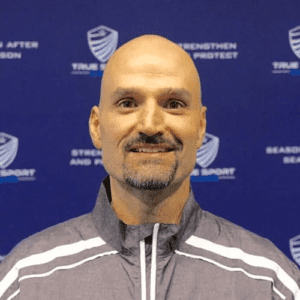ORIGIN:
ASIS (Anterior Superior Iliac Spine) and the anterior part of the iliac crest. If you feel your hip bone in the front, this muscle sits just inferior and lateral to the bony structure.
INSERTION:
ITB (Iliotibial Band) – Since this muscle does not specifically attach to a bone it is of great interest. This also makes the ITB an interesting structure which is detailed in another segment.
ACTION:
Tenses the Fascia Lata which causes abduction, flexion, and internal rotation at the hip joint.
REFERRED PAIN:
In the picture on the right you can see the “X’s.” These mark the areas where trigger points can be located. The red stippled area is the area where pain can be referred. This muscle can cause hip pain, knee pain and thigh pain.
DISCUSSION:
This muscle is very commonly associated with a hip dysfunction. Often times runners will have a misfiring TFL. Anytime we suspect an ITB issue, we always check the TFL for its function. The TFL comprises approximately 25% of the ITB’s superior component, while the Glute Max comprises the other 75%. They should work in concert with one another. The structures that can be related to a dysfunctional TFL are commonly the Glute Max, Glute Medius, Glute Minimus, Vastus Lateralis, QL, and the other hip flexors. This is a great muscle to foam roll, although you should be careful around the area of your greater trochanter. This is the widest part of your hips. There are some burial sacs in the area that you can irritate. If you feel some restrictions or pain, it may be worth a trip to the office!

